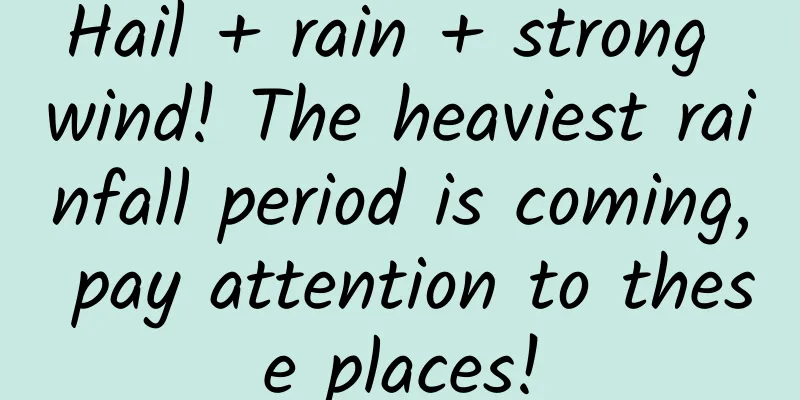Hail + rain + strong wind! The heaviest rainfall period is coming, pay attention to these places!

|
In mid-May, the southern region will enter a rainy period again. It is expected that there will be more rainfall in the south in mid-May, mainly occurring around May 10-12, 14-15, and 17. Among them, from the 10th to the 12th, heavy to torrential rains will occur from west to east and from north to south in central and eastern Guizhou, Jiangnan, central and northern South China , and other places. Parts of central and southern Hunan, central and southern Jiangxi, western Fujian, etc. will have torrential rains. The process will be accompanied by short-term heavy rainfall, with the maximum hourly rainfall of 20 to 50 mm, and up to 70 mm in some local areas. The heaviest rainfall occurred from the night of the 10th to the 11th. From the 14th to the 15th, there will be moderate to heavy rain, and local rainstorms in southern Jiangnan, most of southern China, and Guizhou. Around the 17th, there will be a new round of heavy rainfall in southern China. There will be strong winds and severe convective weather in the northern region from the 10th to the 11th Showers and thunderstorms are expected in Inner Mongolia, North China, Northeast China, Huanghuai and other places, with moderate to heavy rain in some places accompanied by strong convective weather such as thunderstorms, gale, hail, etc. Inner Mongolia, Northeast China, Beijing-Tianjin-Hebei, Huanghuai and other places will have 4-6 wind gusts, with wind speeds reaching 7-9. It is worth noting that Starting from the 10th, strong convective weather will be more obvious in Northeast China and North China, especially in the Northeast where a squall line may appear. The public needs to be highly vigilant against the adverse effects of strong convective weather such as thunderstorms, gales or hail. The north continues to be warm and hot today The summer process in Beijing, Tianjin, Hebei and other places may start from now on In the next few days, the temperature in most parts of northern China will continue to fluctuate and rise, especially in the North China Plain, with many places reaching 30℃ Starting from the 10th, a cold air mass will bring cooling to the northern region, but since the cold air is not strong, the cooling will be limited. Around this weekend, the temperature in North China and Northwest China will rise again. Among them, the highest temperature in Shijiazhuang on the 14th may reach 35℃. The public needs to pay attention to the upcoming warning and forecast information and take precautions against heatstroke. 01 How to deal with thunderstorms 02 How to deal with hail First of all, you should pay attention to weather information. When the meteorological station issues a hail warning, you should try to avoid traveling to avoid unnecessary injuries. Secondly, if you are outdoors and encounter hail, you should immediately hide in a safe room. In windy weather, stay away from high-altitude work facilities, factory sheds, billboards, dilapidated houses and large trees. In thunderstorms, stay away from tall objects such as iron towers, chimneys, and electric poles, and do not hide under large trees or isolated sheds and cabins to avoid the rain. When hail is likely to occur, avoid parking your vehicle under trees. It is recommended to park your vehicle indoors or in underground parking lots, and avoid areas near windows. If you can only park outdoors, consider purchasing a professional vehicle hail protection cover, or prepare a thicker blanket or quilt, install it on the vehicle, and cover it when parking. Pay special attention to protecting vulnerable parts such as the windshield to reduce the risk of the vehicle being damaged. 03 How to deal with high temperatures When a yellow high temperature warning is issued, relevant departments and units should make preparations for heatstroke prevention and cooling in accordance with their duties, minimize outdoor activities in the afternoon, and provide heatstroke prevention and cooling guidance for the elderly, weak, sick, and young people; people working under high temperature conditions and those who need to work outdoors for a long time during the day should take necessary protective measures. When an orange high temperature warning is issued, outdoor activities should be avoided as much as possible during high temperature periods, and people working under high temperature conditions should shorten their continuous working hours; necessary protective measures should be taken for the elderly, weak, sick and young people; and attention should be paid to prevent fires caused by excessive power consumption and excessive power loads such as wires and transformers. When a red high temperature alert is issued, outdoor work should be stopped as much as possible; protective measures should be taken for the elderly, the weak, the sick, and the young, and special attention should be paid to fire safety. Comprehensive sources: CCTV-1, News and Publicity Department of the Ministry of Emergency Management, People's Daily Online, Xinhuanet, |
<<: Can the menstrual cycle "reshape" the brain?
>>: Be careful! A poison that can kill you with just 1 mg may be in your kitchen!
Recommend
Why do you feel sore all over when you have a fever? It's actually a sign that your protection is about to be upgraded
Produced by: Science Popularization China Author:...
Trump has implicated Tesla, is this the opportunity for domestically produced high-end new energy vehicles?
On June 16, because Trump insisted on provoking a...
In-depth analysis of bidding models in Internet advertising
In (Previous article - Basic bidding model), we d...
After upgrading to iOS 15, Meituan was exposed to "locate" every five minutes, and Apple fans finally got angry
[[428179]] Many people may not know that in iOS15...
7 Micro-Interactions to Improve User Experience
[[141728]] As we all know, we always judge a book...
Can a refrigeration and range hood set priced at 30,000 yuan help Fangtai, which is under pressure of hundreds of billions, to calm down?
What new stories can range hoods tell? There is a...
Don’t laugh yet, there really is such a thing as a “sand dollar” in the world…
If you were on the beach and picked up the "...
Programmers are not bricklayers, they are writers
[[134795]] If you have 10 programmers, the best o...
New results from collision! A sensitive probe is now available to explore the difference between positive and negative matter
The Beijing Spectrometer III (BESIII) experiment ...
Analyst Benedict Evans: What changes will happen to the mobile ecosystem in the future
Editor's note: The development of smartphones...
Can eating more sapodilla rice improve your beauty? Its real effect is...
" Eating more sapodilla rice can beautify yo...
Short video planning and operation guide!
During last year's National Day, Zhang Ce and...
Electric car value retention rate list: NIO ES6 and Tesla Model 3 exceed 70%
Recently, Roland Berger released the "2020 C...
The secret to making Tik Tok video ads a hit!
How to shoot a good Douyin video with strong sale...
Tips on how to choose a 400 number when applying for one
Now there are many companies that need to apply f...





![[Hot Mom's Guide] How to quickly recover your girlish figure after childbirth | Use private training](/upload/images/67cc0fbb96898.webp)



